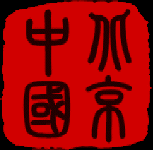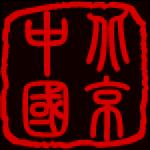 |
Forbidden City |
 |
 |
Forbidden City |
 |
History of the Forbidden City
|
The Purple Forbidden City
|

YongLe's home became known as 'Zi Jin Ch'eng'. This has the meaning : 'the purple city (Ch'eng) of the polestar (Tzu), where one cannot enter (jin)'. The literal meaning of China (ChungHua) is 'the country at the centre' or 'middle kingdom', leading to the idea that the Forbidden City is at the very centre of the world.
The Forbidden City was constructed in accordance with ancient rules of spatial design, first used during the Han dynasty in building the city of Chang'An (modern XiAn), between 206 BC and AD 220 . Among other things, these rules specified that the principal buildings should be aligned along a straight axis from south to north, flanked by a symmetrical arrangement of minor structures on parallel axes. This architectural convention was favourable to YungLo's claim that his city had symbolic importance. He believed that a centralized configuration of buildings would also serve as a reflection of the ordered heavens.
The chilling north was regarded as a harmful direction. Because all invasions of China had originated from the north, it came to represent evil spirits, cold winds and the wicked warriors from the Steppes. Hence, nearly all the buildings in the Forbidden City face south, the direction of holiness, giving protection from icy winds and also permitting subtle decoration based on catching infinite variations of sunlight. In fact, the only pavilions facing north were for the emperor's rejected concubines.
永乐的家变成“紫禁城”,它的意思就是:“紫微正中”之紫,意为皇宫是人间的 “正中”。“禁”则指皇室所居,尊严无比,没人可以进入。中国的字面意思是指“在中心的国家”或“中间的王国”,这样引导出的意思紫禁城就是世界的最中心了。
紫禁城在建筑上的和谐统一是按照古老的建筑空间设计,首次运用是汉代建造的城在长安(现代的西安),在公元前206年到公元220年。在其他的事情上,这个规则指定所有的主建筑物都要沿着一个南北的中轴线排成一排。两边对称排列着一些子建筑在于中轴线平行的线上。这个建筑规则对于永乐想要的有重大象征意义的宫殿是有利的。他认为集中构建建筑物也是上天安排的一个象征。
寒冷的北面被看成是有害的方向,因为中国所有的入侵都来自北面,从西伯利亚来的冷风和恶劣的战争,变成邪恶灵魂的象征。所以,在紫禁城里所有的房子都是面朝南的,一个神圣的方向,也保护着免受冷风的侵袭,也允许那些微妙精致的装饰品去扑捉那变化无穷的阳光。事实上只有一个亭阁是面北的,给那些被皇上遗弃的嫔妃的。

The enclosing wall (being synonymous with the word for 'city' in China) was a major component in city planning, with huge towers over the gates and watchtowers at the four corners.
In part, the chinese philosophy of Taoism seeks harmony with nature. The mysterious art of Feng-Shui (literally, 'wind-water') was used to help harmonize buildings with natural forces. The chinese architectural tradition for placing major buildings along an axis also allowed asymmetrical elements to be introduced, such as the natural release of trees, lakes and canals.
All of the five elemental colors (as specified by chinese philosophers) were introduced in the design of the city : white marble terraces, (almost) black paving of the courtyards, red columns, with yellow roofs, all on a sky blue background as reflected in the moat. The majesty of this purple walled city with its golden yellow rooftops standing tall among all the uniformly grey and far smaller hutongs must have been an extraordinary sight. The high, vermilion palace walls, by keeping the emperor hidden, enhanced his mystique and glory.
Construction of the Forbidden City started in 1406, the 5th year of YongLo's reign. The construction took 14 years - and an estimated one million workers, and 100,000 artisans, were involved.
围绕的城墙也是紫禁城的规划的主要部分之一,包括每个城门上的城门楼和四个拐角的角楼。
在某种程度上,中国的道教寻求人与自然的和谐共存。神秘的风水学(字面是风和水)是用来帮助协调建筑物与自然力量的。中国的传统建筑讲究把主要的建筑沿着一条中轴建设,也允许引进一些不对称的元素,例如自然的湖泊、运河和树。
自然界所有的颜色都包括在这个城的设计里了。白色的大理石,(几乎是)黑色的院面砖,红色的柱子,黄色的屋顶,所有的一切都在天空蓝色的背景下,也同样反映到护城河里。这个雄伟的有着紫色城墙金色屋顶的紫禁城,矗立在千篇一律的灰色的又小的很多的胡同民宅之中一定是非常的耀眼。这高高的红墙把皇帝隐藏在里面,更加凸显了它的神秘和神圣。
紫禁城始建于1406年,永乐统治的第五年。这个建筑总共历时了14年,据估计参加工程的工人有一百万,和十万能工巧匠。
 |
 |
Stones needed were quarried from FangShan, a suburb of Beijing. It is said that a well was dug every 50 meters in order to pour water onto the road in winter to slide the huge stones along ice into the city. In the summer, logs were used to roll the rocks along.
Huge amounts of timbers and other materials were also freighted in, many from faraway provinces.
From its completion in 1420 to 1644, when a peasant revolt invaded it, the Forbidden City served as the seat of the Ming Dynasty. The following Qing Dynasty also resided in the Forbidden City. By the end of the eighteenth century, some 9000 people were estimated to reside there.
After being the home of 24 emperors - fourteen of the Ming dynasty and the ten of the Qing - the Forbidden City ceased being the political center of China in 1912 with the abdication of Pu Yi, the last Emperor of China. He was, however, allowed (in fact, required) to live within the walls of the Forbidden City, until a coup launched by a local general (Feng YuXiang) in 1924 expelled him.
Having been the imperial palace for some five centuries, it houses numerous rare treasures and curiosities. In 1947, after they had been moved from one location to another inside mainland China for many years (most recently to be hidden from the Japanese in the Sino-Japanese war), Chiang Kai-Shek ordered many of the artifacts within the Forbidden City to be moved to Taiwan where they later formed the core of the National Palace Museum in Taipei.
石头是在房山开采的,是北京的一个近郊。据说在路边每50米就要挖一个水井,是为了冬天在地上泼水使之结冰,然后方可把这巨大的石料挪到城内。在夏天,用圆木来向前滚动石料。
大量的木料和其他的材料,也都是从很远的省运过来的。
当农民起义军进攻它的时候,紫禁城结束了作为明朝的宫殿使命从1420年到1644年。随后的清朝也住进了紫禁城里。在十八世纪末,估计大约有9000多人住在里面。
在24个皇帝居住之后(14个明朝的,10个清朝的),在1912年中国的最后一个皇帝溥仪退位之后,紫禁城结束了它作为中国政治中心的使命。然而他仍被允许(实际上,必须的)住在紫禁城里,直到1924年军阀冯玉祥发动了政变,把他驱逐出去。
它作为皇宫大约有5个世纪,里面收藏了大量的稀世珍宝。1947年,在它们被从一个地方转移到另一个地方之后(在甲午战争时期为了防止日本人),蒋介石下令把故宫里大部分的财宝都运到台湾,它们便是之后在台北的故宫博物院的核心。

Just a few of the many golden yellow
rooftops,
with the White Dagoba in Beihai Park visible in the
distance.
This action has been extremely controversial, with some regarding it as looting with others regarding it as safekeeping, especially given the events of the Cultural Revolution on the mainland. However, many treasures (about 1 million) are now housed within the Forbidden City - and many of these are on display to visitors, including gifts of state, military campaign treasures, and the furnishings and possessions of members of the imperial household. Many others (about 650,000 objects) remain in the National Museum in Taipei, Taiwan.
这一举动极具争议的,有些人把他看作是掠夺有些人把他看作保护,尤其是在文化大革命时期。然而,一些文物(大约一百万)现在仍在紫禁城里,而且大部分都展出给游人们包括一些外国进贡的礼物,战争中的宝贝,一些家具设备和皇族成员的遗物。另外一些(大约65万件)在台湾台北的故宫博物院里。
If we look at a map of Beijing from around 1600, we can see it is quite familiar in many ways. Some of the roads familiar today existed then - such as the shopping streets of WanFuJing and XiDan. We can also see that the subway loop line (line 2) follows the path of the old city wall and that the second ring road follows it too - following the extended city wall to the south. The old city walls are shown in red.
如果我们看1600年北京的地图,我们可以看见很多相似的地方。许多熟悉的路今天仍然存在——像王府井和西单的购物街。我们也能看出2号环线地铁和二环路都是沿着旧城墙的——跟随着南面延伸出的旧城墙。旧城墙用红色标出。

A part of the old city wall can be seen at ChongWenMen ('men' means gate in chinese). An old gate still exists at DeShengMen. Parts of the moat / canal also still exist, at least in location, including most of the canal that could transport the emperor to the Summer Palace (YiHeYuan).
An important thing to note is the importance of the north-south axis in the imperial city, extending from the drum and bell towers in the north to the Temple of Heaven in the south. Today, the primary axis is east - west with the creation of the grand boulevard ChangAn. On the map, the location of ChangAn is shown in pale grey/green; it hardly existed in the days of the Ming Dynasty.
In the southern part of the outer city is the Temple of Heaven (TianTan). To the north of the inner city is Ditan (terrace), to the east Ritan and west Yuetan, forming the four perpheral key points, clustered around the imperial city. The Imperial Ancestral Temple (TaiMiao) and the altar for worshipping the god of the land and the god of grain (SheJiTan) were located on the left and right sides in front of Wumen, the front gate of the Forbidden City (now called ZhongShan park and the Working People's Cultural park respectively).
On the annual Winter Solstice (22nd solar term), the Summer Solstice (10th solar term), the Spring Equinox (4th solar term), and Autumnal Equinox (16th solar term), the emperor went to TianTan, DiTan, RiTan and YueTan respectively to perform sacrificial rites. The correspondence of TianTan, DiTan, RiTan and YueTan to winter, summer, spring and autumn, and also to south, north, east and west, demonstrated the ancient chinese world outlook on the integration of man and heaven.
在崇文门那仍然存在一段老的城墙。一个老城门仍然在德胜门。一段护城河仍然存在,至少在许多可以送皇上到颐和园的运河中有一段存在。
一个重要的事件解释了皇城里南北中轴线的重要,它延伸出来北到钟鼓楼,南到天坛。今天重要的坐标轴是东西走向的,宏伟的长安大街。在地图上长安街是用浅灰或浅绿色标出的,它几乎在明朝的时候就存在了。
在南面的市郊有天坛,在市中心的被面是地坛,东面是日坛,西面是月坛。这四个重要的关键点围绕着皇城。皇帝的祖先的庙(太庙)和供奉的土地神和五谷神的寺庙(社稷坛)在皇城的东西两侧紫禁城的大门——午门的前面,现在的中山公园和劳动人民文化公园。
在每年的冬至(第22个节气),夏至(第10个节气),春分(第4个节气),秋分(第16个节气),皇帝都会分别到天坛、地坛、日坛、月坛,举行祭祀大典。他们一次对应的顺序是:天坛、地坛、日坛、月坛,对应,冬季、夏季、春季、秋季,也对应着,南、北、东、西,它充分的展示了古代中国天人合一的世界观。


 Forbidden City
Forbidden City
: Introduction
 Forbidden City : History
Forbidden City : History
 Forbidden City : Layout
Forbidden City : Layout
 Forbidden City : Map
Forbidden City : Map
 Getting there
Getting there

 The
Meridian Gate (outside)
The
Meridian Gate (outside)
 The
Meridian Gate (inside)
The
Meridian Gate (inside)
 The
First Courtyard
The
First Courtyard
 The
Gate of Supreme Harmony
The
Gate of Supreme Harmony
 The
Second Courtyard
The
Second Courtyard
 The
Hall of Supreme Harmony (part 1)
The
Hall of Supreme Harmony (part 1)
 The
Hall of Supreme Harmony (part 2)
The
Hall of Supreme Harmony (part 2)
 The
Hall of Complete Harmony
The
Hall of Complete Harmony
 The
Hall of Preserving Harmony
The
Hall of Preserving Harmony

 The
Gate of Celestial Purity
The
Gate of Celestial Purity
 The
Hall of Celestial Purity
The
Hall of Celestial Purity
 The
Hall of Celestial and Terrestrial Union
The
Hall of Celestial and Terrestrial Union
 The
Hall of Terrestrial Tranquility
The
Hall of Terrestrial Tranquility
 The
Imperial Garden
The
Imperial Garden
 The
Imperial Garden (part 2)
The
Imperial Garden (part 2)
 The
Exhibition Halls
The
Exhibition Halls
 The
9 Dragon Screen
The
9 Dragon Screen
 Other
Places of Interest
Other
Places of Interest

 Doorways
Doorways
 Doorways
(part 2)
Doorways
(part 2)
 Pots
Pots
 Sculptures
Sculptures
 Decorative
Tiles
Decorative
Tiles
 Roofs
Roofs
 Beams
and Ceilings
Beams
and Ceilings
 Windows
and Doors
Windows
and Doors
 Gorgoyles
Gorgoyles
 Ballustrades
Ballustrades
 Walls
& Screens
Walls
& Screens

Share this page

Quick Links
Top travel guides
 Great Wall Beijing
Great Wall Beijing
 YuanMingYuan
Park
YuanMingYuan
Park
 Next : Layout of the Forbidden City
Next : Layout of the Forbidden City
 Forbidden City
Forbidden City
Introduction
China Travel and Culture Videos Home